Introduction to Feature Engineering
Feature engineering is a critical step in the data science pipeline, transforming raw data into meaningful features that can improve the performance of machine learning models. It involves selecting, modifying, and creating variables (features) from the raw data that will allow algorithms to learn patterns more effectively.
In this article, we will explore the various aspects of feature engineering, its importance, techniques, and best practices.
Why is Feature Engineering Important?
Feature engineering is often considered the most crucial part of a machine learning project. The quality of the features you use can significantly impact the performance of your models. Even the most sophisticated algorithms can fail to deliver accurate predictions if the features are not well-engineered.
Key Benefits of Feature Engineering:
-
Improves Model Accuracy: Properly engineered features can make patterns in the data more apparent, leading to better model performance.
-
Reduces Overfitting: By creating features that capture the underlying data patterns, you can reduce the risk of overfitting.
-
Simplifies Model Complexity: Good features can lead to simpler models that are easier to interpret and maintain.
-
Speeds Up Learning: Well-engineered features can make the training process faster by reducing the dimensionality and complexity of the data.
Types of Features in Machine Learning
Understanding the types of features is essential in the feature engineering process. Here are the common types:
1. Numerical Features
-
Continuous Features: These are features that can take any value within a range, like age, temperature, or income.
-
Discrete Features: These are countable features, such as the number of children, the number of products purchased, etc.
2. Categorical Features
-
Ordinal Features: Categorical features with a meaningful order, like education level (high school, bachelor’s, master’s).
-
Nominal Features: Categorical features without a specific order, such as color, gender, or country.
3. Date and Time Features
-
Features related to dates and times, such as year, month, day of the week, and hour of the day.
4. Text Features
-
Features derived from text data, including word counts, sentiment analysis scores, and keyword presence.
Techniques of Feature Engineering
There are various techniques you can use to create and refine features. Below are some of the most common:
1. Handling Missing Values
Missing data is a common issue in datasets. Techniques include:
-
Imputation: Replacing missing values with the mean, median, or mode of the column.
-
Deletion: Removing rows or columns with missing data (used sparingly to avoid data loss).
-
Indicator Variables: Creating a new feature that indicates whether data was missing or not.
2. Encoding Categorical Variables
Since most machine learning algorithms require numerical input, categorical variables need to be encoded:
-
One-Hot Encoding: Creating binary columns for each category.
-
Target Encoding: Replacing categories with the mean of the target variable.
3. Feature Scaling
Scaling makes sure that all features have the same impact on the model. This process adjusts the range of feature values so that no single feature dominates others due to its scale. Common scaling methods include:
-
Standardization: Rescaling features to have a mean of 0 and a standard deviation of 1.
-
Normalization: Rescaling features to a range between 0 and 1.
4. Feature Creation
Creating new features can provide extra information that might be useful for the model.
-
Polynomial Features: Creating interaction terms between numerical features.
-
Log Transformations: Applying logarithms to skewed distributions to reduce skewness.
-
Binning: Converting continuous variables into categorical ones by dividing them into bins.
5. Feature Selection
Not all features are useful for modeling. Feature selection involves choosing the most important features:
-
Filter Methods: Selecting features based on statistical tests (e.g., correlation).
-
Wrapper Methods: Selecting features based on model performance (e.g., forward selection).
-
Embedded Methods: Feature selection that occurs during model training (e.g., Lasso regression).
6. Feature Extraction
Feature extraction reduces the dimensionality of the data:
-
Principal Component Analysis (PCA): A technique that reduces the dimensionality by transforming features into principal components.
-
Linear Discriminant Analysis (LDA): Used for dimensionality reduction while maintaining class separability.
Best Practices in Feature Engineering
Feature engineering is both an art and a science. Here are some best practices to follow:
1. Understand the Data
-
Spend time exploring the data to understand its characteristics and relationships. Use visualizations, statistics, and domain knowledge to guide your feature engineering process.
2. Start Simple
-
Begin with simple features and gradually move to more complex ones. Sometimes, basic transformations can have a significant impact on model performance.
3. Iterative Process
-
Feature engineering is an iterative process. Test different features, evaluate their impact, and refine them based on model performance.
4. Avoid Data Leakage
-
Ensure that no information from the target variable leaks into the features during feature creation, as this can lead to overly optimistic model performance.
5. Consider Feature Interaction
-
Explore interactions between features. Sometimes, combining two or more features can reveal patterns that are not evident when features are considered individually.
6. Automation and Tools
-
Utilize tools and libraries that assist in feature engineering, such as Featuretools for automated feature generation or Scikit-learn for various preprocessing methods.
7. Cross-Validation
-
Always validate your engineered features using cross-validation to ensure they generalize well to unseen data.
Common Challenges in Feature Engineering
Feature engineering is a complex task that comes with its challenges:
1. High Dimensionality
-
Creating too many features can lead to the curse of dimensionality, making the model harder to train and interpret.
2. Overfitting
-
Over-engineering features can lead to models that perform well on training data but fail on unseen data.
3. Domain Knowledge Requirement
-
Effective feature engineering often requires deep domain knowledge, which may not always be available.
4. Computational Cost
-
Some feature engineering techniques can be computationally expensive, especially with large datasets.
Tools and Libraries for Feature Engineering
There are several tools and libraries that can assist you in the feature engineering process:
1. Pandas
-
A powerful library for data manipulation and analysis, often used for feature engineering tasks.
2. Scikit-learn
-
Provides numerous preprocessing techniques like scaling, encoding, and feature selection.
3. Featuretools
-
A library specifically designed for automated feature engineering, especially useful for time-series data.
4. TensorFlow and PyTorch
-
Both frameworks provide utilities for custom feature engineering in deep learning models.
5. Matplotlib and Seaborn
-
Visualization libraries that help in understanding and engineering features through data exploration.
Conclusion
Feature engineering is an essential step in the machine learning pipeline, significantly influencing the performance of your models. By understanding the types of features, employing various techniques, and following best practices, you can create features that enhance your model’s predictive power. Whether you’re working on Artificial Intelligence Training in Noida, Delhi, Mumbai, Indore, and other parts of India, mastering feature engineering is crucial to improving the accuracy and effectiveness of your AI models.
Whether you’re a beginner or an experienced data scientist, mastering feature engineering will give you a competitive edge in building robust, accurate machine learning models.



